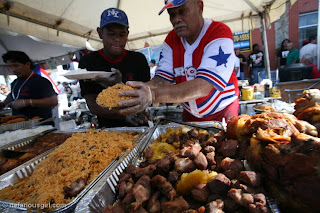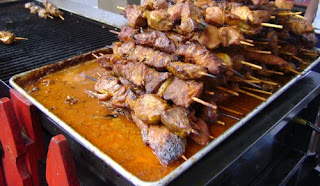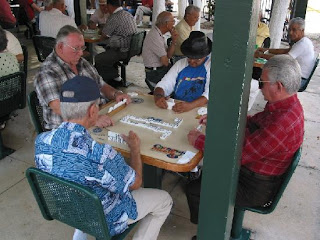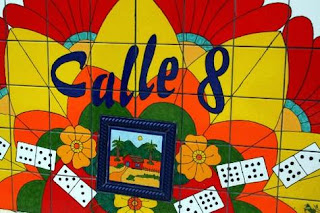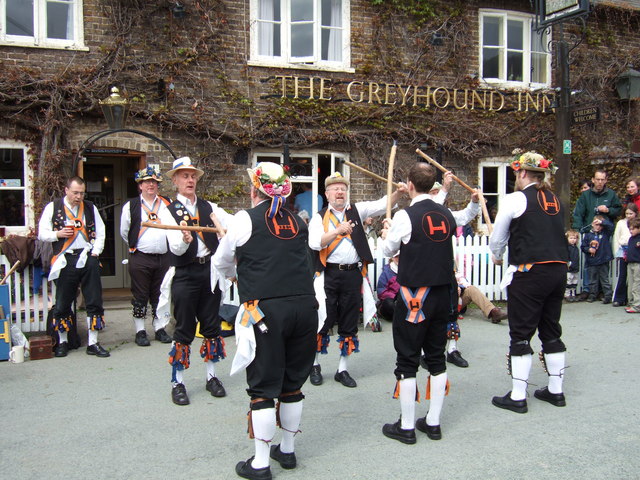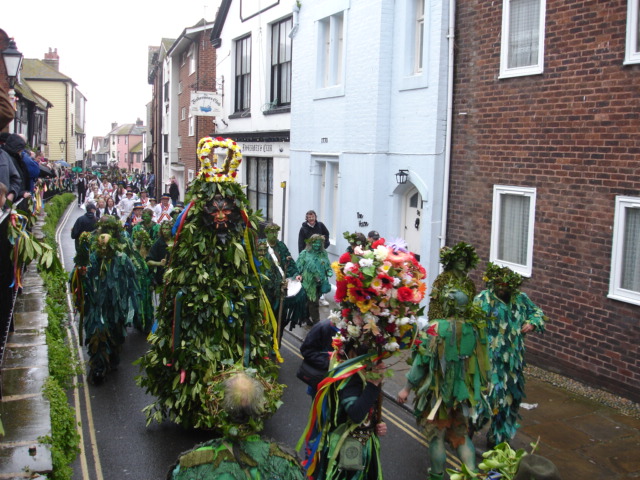May Day on May 1st, is an ancient Northern Hemisphere spring pameran and usually a public holiday;
it is also a traditional spring holiday in many cultures.
Traditional May Day Celebrations May Day is related to the Celtic pameran of Beltane and the Germanic pameran of Walpurgis Night. May Day falls exactly half a year from November 1, another cross-quarter day which is also associated with various northern European pagan and the year in the Northern hemisphere, and it has traditionally been an occasion for popular and often raucous celebrations.
As Europe became Christianized, the pagan holidays lost their religious character and either changed into popular secular celebrations, as with May Day, or were merged with or replaced by new Christian holidays as with Christmas, Easter, Pentecost and All Saint's Day. In the twentieth and continuing into the twenty-first century, many neopagans began reconstructing the old traditions and celebrating May Day as a pagan religious pameran again.
Origins
The earliest May Day celebrations appeared in pre-Christian times, with the pameran of Flora, the Roman goddess of flowers, and the Walpurgis Night celebrations of the Germanic countries. It is also associated with the Gaelic Beltane. Many pagan celebrations were abandoned or Christianized during the process of conversion in Europe. A more secular version of May Day continues to be observed in Europe and America. In this form, May Day may be best known for its tradition of dancing the maypole dance and crowning of the Queen of the May. Various Neopagan groups celebrate reconstructed (to varying degrees) versions of these customs on May 1st.
The day was a traditional summer holiday in many pre-Christian European pagan cultures. While February 1 was the first day of Spring, May 1 was the first day of summer; hence, the summer solstice on June 25 (now June 21) was Midsummer. In the Roman Catholic tradition, May is observed as Mary's month, and in these circles May Day is usually a celebration of the Blessed Virgin Mary. In this connection, in works of art, school skits, and so forth, Mary's head will often be adorned with flowers in a May crowning. Fading in popularity since the late 20th century is the giving of "May baskets," small baskets of sweets and/or flowers, usually left anonymously on neighbours' doorsteps.
Europe
Great Britain
Roodmas was a Christian Mass celebrated in England at midnight on May 1.
Traditional British May Day rites and celebrations include Morris dancing, crowning a May Queen and celebrations involving a Maypole. Much of this tradition derives from the pagan Anglo-Saxon customs held during "Þrimilci-mÅnaþ"
(the Old English name for the month of May meaning
Month of Three Milkings) along with many Celtic traditions.
May Day has been a traditional day of festivities throughout the centuries. May Day is most associated with towns and villages celebrating springtime fertility and revelry with village fetes and community gatherings. Since the reform of the Catholic Calendar, May 1st is the Feast of St Joseph the Worker, the patron saint of workers. Seeding has been completed by this date and it was convenient to give farm labourers a day off. Perhaps the most significant of the traditions is the Maypole, around which traditional dancers circle with ribbons.
The May Day bank holiday, on the first Monday in May, was traditionally the only one to affect the state school calendar, although new arrangements in some areas to even out the length of school terms mean that the Good Friday and Easter Monday bank holidays, which vary from year to year, may also fall during term time. The May Day bank holiday was created in 1978. In February 2011, the UK Parliament was reported to be considering scrapping the bank holiday associated with May Day, replacing it with a bank holiday in October, possibly co-inciding with Trafalgar Day (celebrated on 21 October), to create a "United Kingdom Day".
 |
| May Day 1904 |
May Day was abolished and its celebration banned by puritan parliaments during the Interregnum, but reinstated with the restoration of Charles II in 1660.
1 May 1707 was the day the Act of Union came into effect, joining England and Scotland to form the Kingdom of Great Britain.
In
Oxford, it is traditional for May Morning revellers to gather below the Great Tower of Magdalen College at 6:00 am to listen to the college choir sing traditional madrigals as a conclusion to the previous night's celebrations. It is then thought to be traditional for some people to jump off Magdalen Bridge into the River Cherwell. However this has actually only been fashionable since the 1970s, possibly due to the presence of TV cameras. In recent years, the bridge has been closed on 1 May to prevent people from jumping, as the water under the bridge is only 2 feet (61 cm) deep and jumping from the bridge has resulted in serious injury in the past. There are still people who insist on climbing the barriers and leaping into the water, causing themselves injury.
In
Durham, students of the University of Durham gather on Prebend's Bridge to see the sunrise and enjoy festivities, folk music, dancing, madrigal singing and a barbecue breakfast. This is an emerging Durham tradition, with patchy observance since 2001.
Whitstable, Kent, hosts a good example of more traditional May Day festivities, where the Jack in the Green pameran was revived in 1976 and continues to lead an annual procession of morris dancers through the town on the May Bank Holiday. A separate revival occurred in
Hastings in 1983 and has become a major event in the town calendar. A traditional Sweeps Festival is performed over the May bank holiday in
Rochester, Kent, where the Jack in the Green is woken at dawn on 1 May by Morris dancers.
At 7:15 p.m. on 1 May each year, the Kettle Bridge Clogs morris dancing side dance across Barming Bridge (otherwise known as the Kettle Bridge), which spans the River Medway near Maidstone, to mark the official start of their morris dancing season. Also know as Ashtoria Day in Northern parts of rural Cumbria. A celebration of unity and female bonding. Although not very well known, it is often cause for huge celebration.
The
Maydayrun involves thousands of motorbikes taking a 55-mile (89 km) trip from
London (
Locksbottom) to the
Hastings seafront, East Sussex. The event has been taking place for almost 30 years now and has grown in interest from around the country, both commercially and publicly. The event is not officially organised; the police only manage the traffic, and volunteers manage the parking.
Padstow in Cornwall holds its annual 'Obby-Oss' (Hobby Horse) day of festivities. This is believed to be one of the oldest fertility rites in the UK; revellers dance with the Oss through the streets of the town and even through the private gardens of the citizens, accompanied by accordion players and followers dressed in white with red or blue sashes who sing the traditional 'May Day' song. The whole town is decorated with springtime greenery, and every year thousands of onlookers attend. Prior to the 19th century distinctive May day celebrations were widespread throughout West Cornwall, and are being revived in
St. Ives and
Penzance.
Kingsand,
Cawsand and
Millbrook in Cornwall celebrate Flower Boat Ritual on the May Day bank holiday. A model of the ship The Black Prince is covered in flowers and is taken in procession from the Quay at Millbrook to the beach at Cawsand where it is cast adrift. The houses in the villages are decorated with flowers and people traditionally wear red and white clothes. There are further celebrations in Cawsand Square with Morris dancing and May pole dancing.
In
St Andrews, some of the students gather on the beach late on April 30 and run into the North Sea at sunrise on May Day, occasionally naked. This is accompanied by torchlit processions and much elated celebration.
Both
Edinburgh and
Glasgow organize Mayday festivals and rallies. In Edinburgh, the Beltane Fire Festival is held on the evening of May eve and into the early hours of May Day on the city's Calton Hill. An older Edinburgh tradition has it that young women who climb Arthur's Seat and wash their faces in the morning dew will have lifelong beauty.
Ireland
May Day has been celebrated in Ireland since pagan times as the feast of Bealtaine and in latter times as Mary's day. Traditionally, bonfires were lit to mark the coming of summer and to banish the long nights of winter. Officially Irish May Day holiday is the first Monday in May. Old traditions such as bonfires are no longer widely observed, though the practice still persists in some communities, such as Arklow, County Wicklow.



